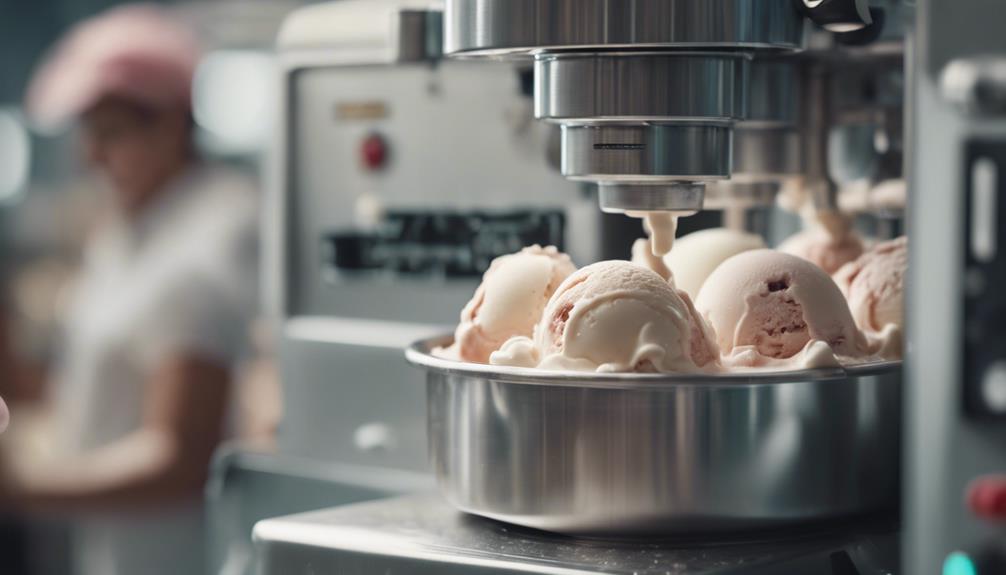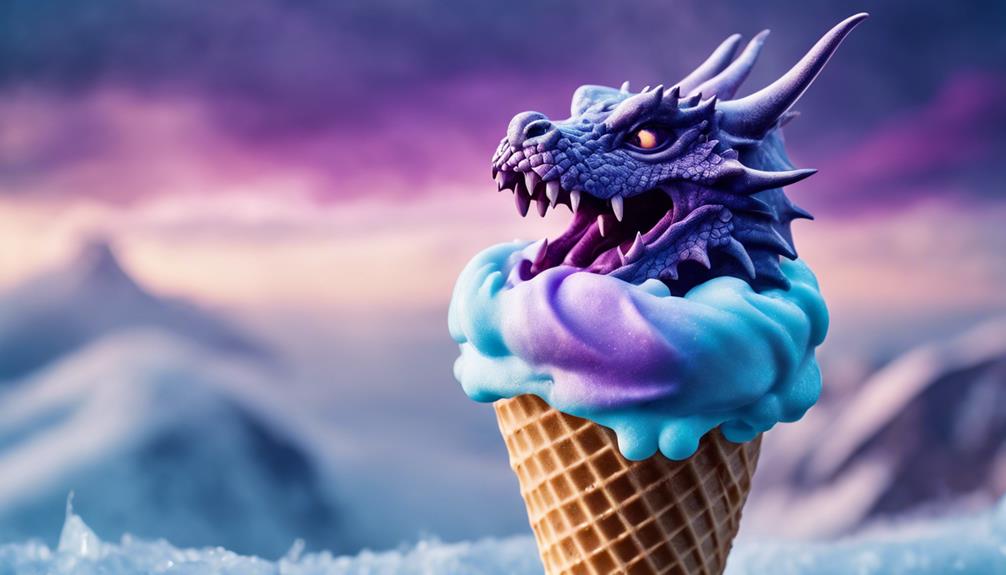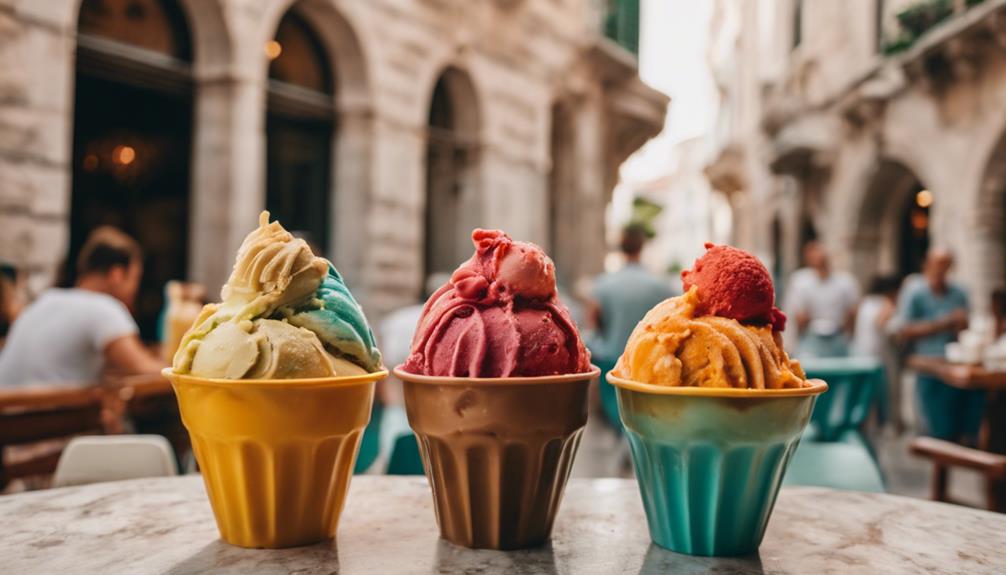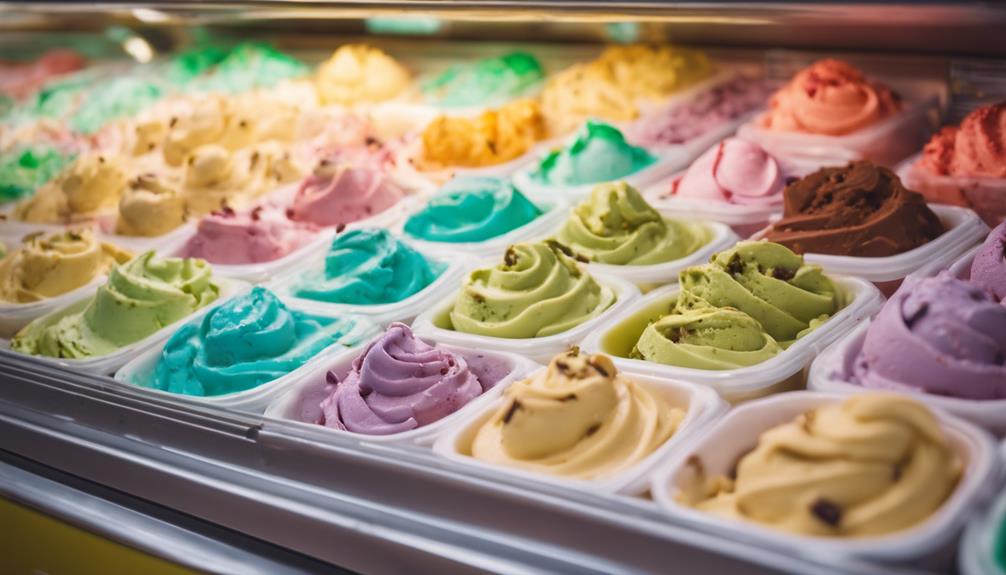Prepare yourself to discover the enchantment behind your favorite dessert! An ice cream maker combines a freezer bowl or compressor for cooling, a churning paddle for texture, and a container for mixing. As your mixture chills and churns, air is incorporated to create a light and creamy result. The components of the machine are crucial for achieving the smooth consistency of the final product. If you are interested in learning more about the fascinating process that transforms basic ingredients into a delightful treat, there is a wealth of information for you to explore!
Key Takeaways
- Freezing bowl or compressor chills mixture rapidly.
- Churning paddle adds air for creamy texture.
- Ingredients determine smoothness and mouthfeel.
- Continuous stirring essential for consistent texture.
- Understanding components ensures proper operation.
Ice Cream Maker Components
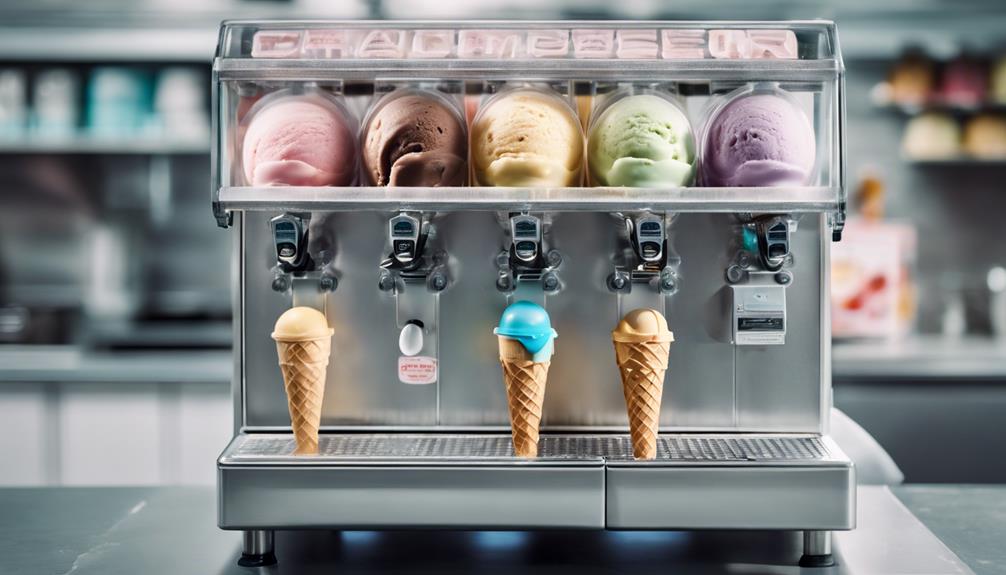
The ice cream maker components include a freezer bowl or compressor, a churning paddle, a container for the mixture, and a chilling and stirring mechanism.
The freezer bowl or compressor provides the freezing power needed to transform liquid ingredients into creamy ice cream. As the mixture freezes, the churning paddle works to incorporate air, prevent ice crystals from forming, and create a smooth and creamy texture.
The container plays a vital role in holding the mixture during the freezing and churning process. It ensures that the ingredients are evenly mixed and continuously stirred, resulting in a consistent texture.
The chilling and stirring mechanism maintains a cold temperature and controls the speed of churning, both of which are essential factors in determining the final consistency of the ice cream. Understanding how each component works together is key to mastering the art of creating delicious homemade treats with your ice cream maker.
Ice Cream Making Process
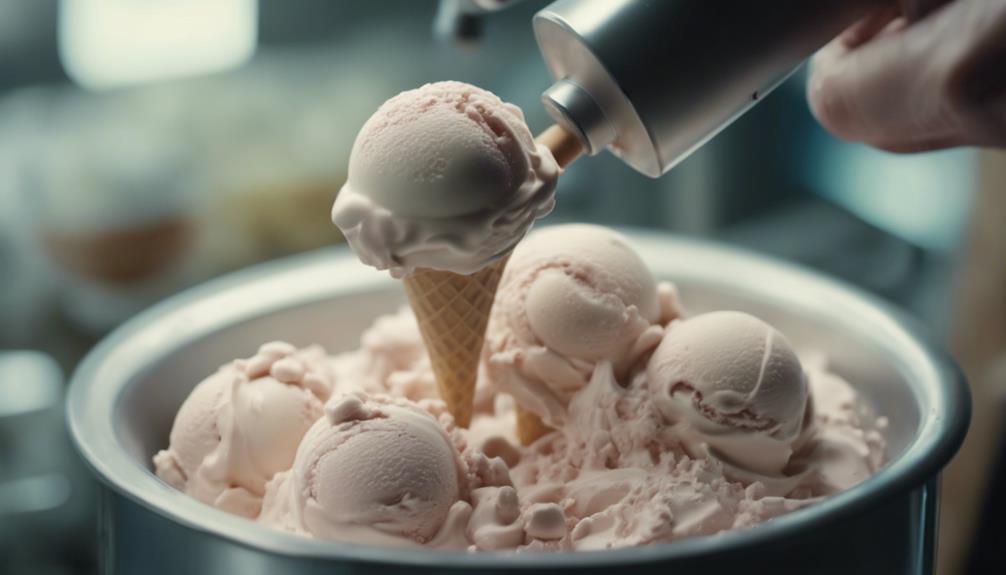
To create delicious ice cream, the mixture is rapidly cooled through freezing, solidifying the cream and milk. Once the mixture is chilled, it undergoes churning to incorporate air, giving the ice cream a light and creamy texture.
The size of ice crystals formed during freezing greatly influences the overall mouthfeel of the ice cream. Continuous stirring during the freezing process is pivotal as it prevents the development of large ice crystals, resulting in a smoother consistency.
Various ingredients in the mixture, such as fat, sugar, and stabilizers, are essential in determining the final texture of the ice cream. The fat content contributes to richness, sugar helps in achieving the desired sweetness, and stabilizers assist in maintaining a smooth and creamy texture.
Types of Ice Cream Makers
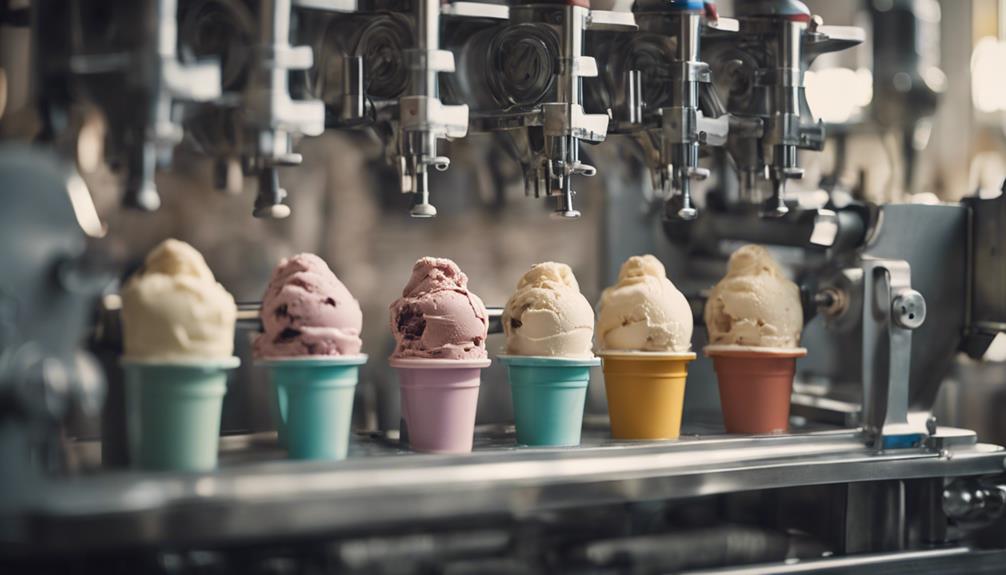
Let's explore the various types of ice cream makers available to help you whip up your favorite frozen treats.
From freezer bowl models to compressor machines, each type comes with its unique features and benefits.
Maker Varieties Overview
Explore the diverse varieties of ice cream makers available to suit different preferences and needs. Whether you enjoy the convenience of freezer bowl ice cream makers, the efficiency of compressor types, the nostalgia of hand-crank models, or the novelty of soft-serve machines, there's a perfect option for you.
Freezer bowl ice cream makers are popular for their simplicity and affordability, requiring pre-frozen bowls to chill the mixture during preparation.
On the other hand, compressor ice cream makers feature built-in freezing systems, eliminating the need for pre-freezing and offering more immediate results.
If you appreciate the traditional charm of homemade ice cream, hand-crank ice cream makers provide a hands-on experience through manual churning.
In contrast, soft-serve ice cream makers are designed specifically for creating smooth and creamy soft-serve style treats, perfect for a fun and unique dessert experience.
Understanding the different types of ice cream makers allows you to choose the one that best suits your preferences and lifestyle.
Key Features Comparison
Comparing the key features of different types of ice cream makers helps you make an informed choice based on your preferences and needs. When deciding on an ice cream maker, consider the following:
- Freezer Bowl Ice Cream Makers: These require you to freeze the ice cream bowl beforehand, making them ideal for those who plan ahead and have enough freezer space.
- Compressor Ice Cream Makers: With a built-in freezing system, these allow you to freeze the ice cream immediately without any pre-planning, perfect for those who want instant gratification.
- Hand-Crank Ice Cream Makers: Ideal for a more hands-on approach, these involve manual churning, giving you a traditional and interactive ice cream-making experience.
- Soft-Serve Ice Cream Makers: Specifically designed for creating soft-serve style treats, these machines freeze the ice cream quickly and dispense it in a ready-to-eat form, great for a quick fix of your favorite dessert.
Understanding these key features will help you choose the ice cream maker that best suits your lifestyle and preferences.
Machine Selection Guide
To select the right ice cream maker for your needs, consider the various types available and their specific features. Ice cream machines work in different ways to churn out delicious frozen treats.
Freezer Bowl ice cream makers require pre-freezing the bowl before using it, making them a simple and affordable option.
On the other hand, Compressor ice cream makers come with a built-in freezing system, eliminating the need for pre-freezing and allowing for continuous batches.
If you enjoy a hands-on approach, Hand-Crank ice cream makers involve manual churning, providing a nostalgic ice cream-making experience.
Soft-Serve ice cream machines are perfect for creating the classic soft-serve style ice cream found in many shops.
Ice Cream Maker Usage Instructions
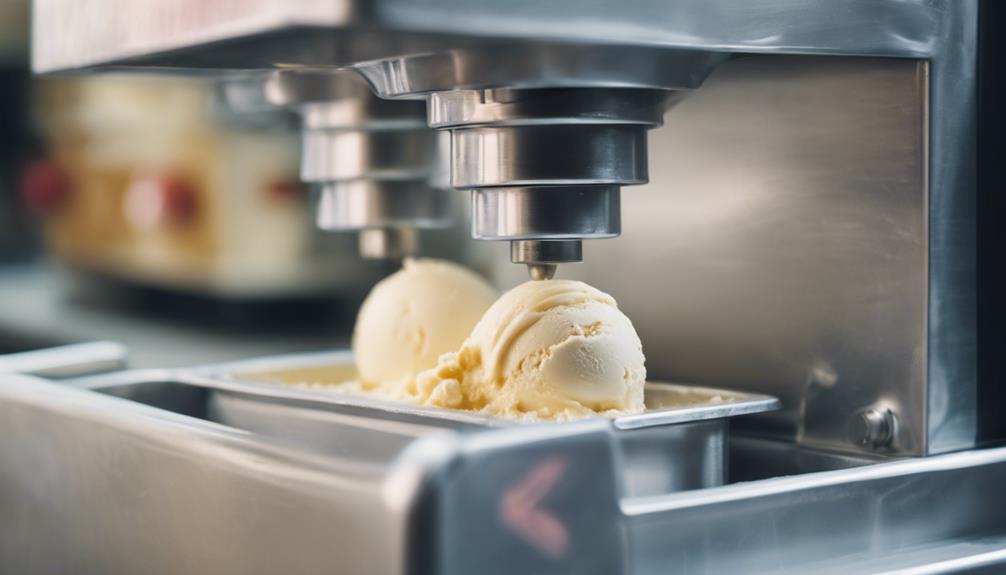
Now, let's talk about how to operate your ice cream maker efficiently. Understanding the churning and freezing process is essential for achieving that perfect creamy texture.
Regular maintenance and cleaning are important for keeping your machine in top condition for delicious batches of ice cream every time.
Operating the Ice Cream Maker
Prepare the ice cream mixture according to your recipe before operating the ice cream maker. Once your mixture is ready, it's time to start making your delicious treat!
- Churn with Care: Whether you're using a hand crank or an electric ice cream maker, make sure that the mixture is churned thoroughly to incorporate air and prevent ice crystals.
- Freezing Power: Understand how your specific ice cream maker works. For instance, with a Cuisinart ice cream maker, freeze the bowl beforehand to achieve the perfect consistency.
- Watch the Clock: Keep an eye on the timer. Different machines may require varying amounts of time, but generally, it takes around 20 minutes for the mixture to reach the desired texture.
- Texture Matters: Remember that the speed of churning and maintaining a cold temperature are key factors in creating the creamy texture you desire.
Churning and Freezing Process
Understanding the churning and freezing process in your ice cream maker is essential for achieving the perfect creamy texture in your homemade ice cream. When you use an ice cream maker, churning incorporates air into the mixture, creating a light and fluffy texture. Simultaneously, rapid freezing solidifies the cream and milk, resulting in a creamy consistency. The continuous stirring in the ice cream maker prevents the formation of large ice crystals, ensuring a smooth texture. Factors like churning speed and cold temperature significantly influence the final consistency of the ice cream. Ingredients such as fat, sugar, and stabilizers also impact the texture and overall quality of the ice cream produced in the ice cream maker.
| Churning and Freezing Process in an Ice Cream Maker | |||
|---|---|---|---|
| Benefit | Description | ||
| Incorporates Air | Light and Fluffy | ||
| Rapid Freezing | Creamy Consistency | ||
| Continuous Stirring | Prevents Ice Crystal Formation |
Maintenance and Cleaning
Proper maintenance and cleaning of your ice cream machine are essential for peak performance and safe usage. Neglecting these tasks can lead to bacterial growth, affecting the quality of your delightful frozen treats.
Here are some tips to help you keep your ice cream maker in top shape:
- Regular Cleaning: Make it a habit to clean your machine after each use to prevent residue buildup and bacterial contamination.
- Utilize Automated Cleaning Cycles: Take advantage of machines with automated cleaning cycles to simplify the cleaning process and secure thorough sanitation.
- Thorough Disassembly: Regularly disassemble parts for a deep clean, as this aids in preventing bacterial growth and maintaining a safe environment for food preparation.
- Sanitation Practices: Adhere to proper sanitation practices to uphold the hygiene standards of your ice cream maker, securing the longevity of the machine and the quality of your ice cream.
Additional Information
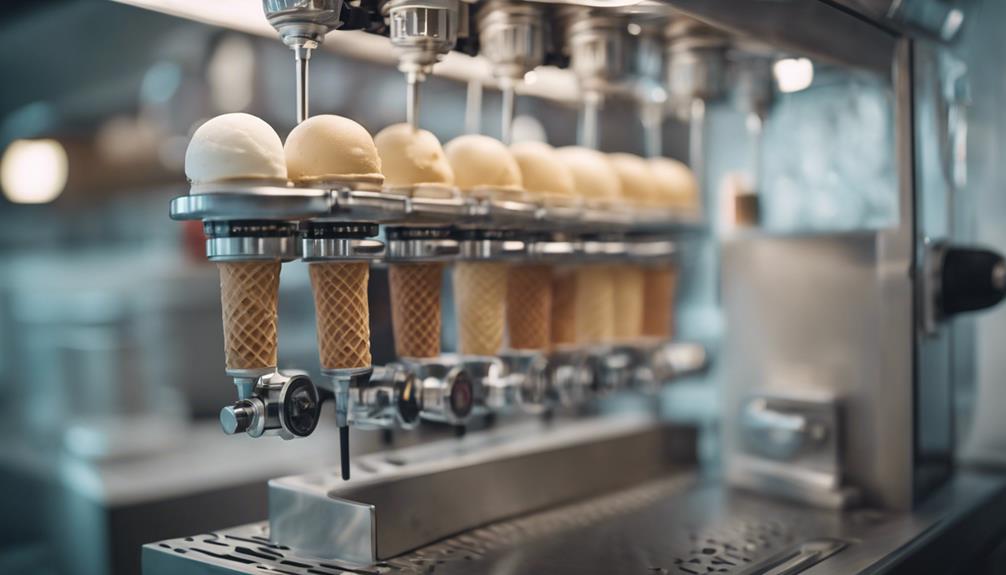
You might find it interesting to know that ice cream machines come in various sizes and capacities to cater to different needs and preferences. These machines are designed to efficiently freeze and churn the ice cream mixture to achieve that creamy, delicious consistency we all love.
The high-speed electric motor in ice cream machines rotates the canister and scraper, aiding in the freezing process against the canister's inner wall. Additionally, the cooling system plays an essential role by circulating refrigerant around the mix to chill and freeze it effectively.
Inside the ice cream machine, the freezing cylinder works diligently to solidify the ice cream mix to the desired texture. The dasher, or agitator, is responsible for mixing the ice cream continuously to prevent the formation of large ice crystals, ensuring a smooth and creamy end product.
Finding the Right Ice Cream Machine
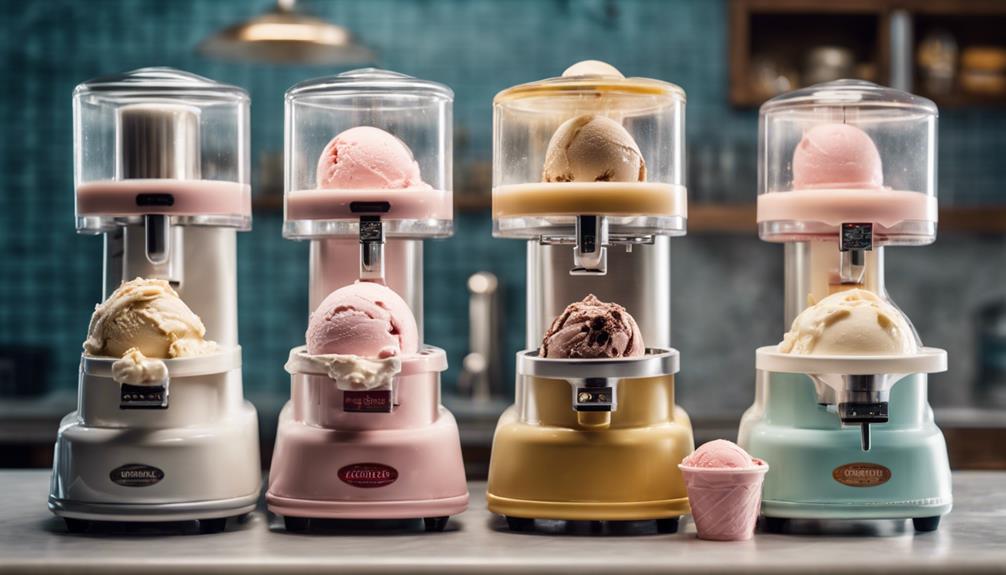
When selecting an ice cream machine, it's essential to evaluate your specific production needs for the best performance and efficiency. Here are some key factors to ponder:
- Batch or Continuous Freezer: Determine whether you need a batch freezer for small artisanal batches or a continuous freezer for high-volume production.
- Capacity: Evaluate the machine's capacity to make sure it aligns with your output requirements.
- Power Consumption: Ponder the energy efficiency of the ice cream machine to reduce operational costs.
- Size vs. Specialty: Choose between a smaller machine for unique, specialty flavors or a larger one for a bustling ice cream shop catering to high demand.
Comparing Ice Cream Machines

One key aspect when comparing ice cream machines is their volume, as it directly correlates to the amount of ice cream each machine can produce at a time. The volume of ice cream machines can vary significantly, with some capable of producing small batches suitable for home use, while others are designed for high-demand commercial settings.
When evaluating volume, it's crucial to align the machine's production capabilities with your needs to ensure effective operation.
In addition to volume, power consumption is another crucial factor to take into account when comparing ice cream machines. Energy-efficient models can help decrease operating costs over time, making them a more sustainable choice for your business.
Furthermore, price ranges for ice cream machines can vary widely, reflecting differences in volume, features, and overall quality. It's important to weigh the initial cost against long-term benefits to make an informed decision.
Key Components of a Commercial Soft Serve Ice Cream Machine
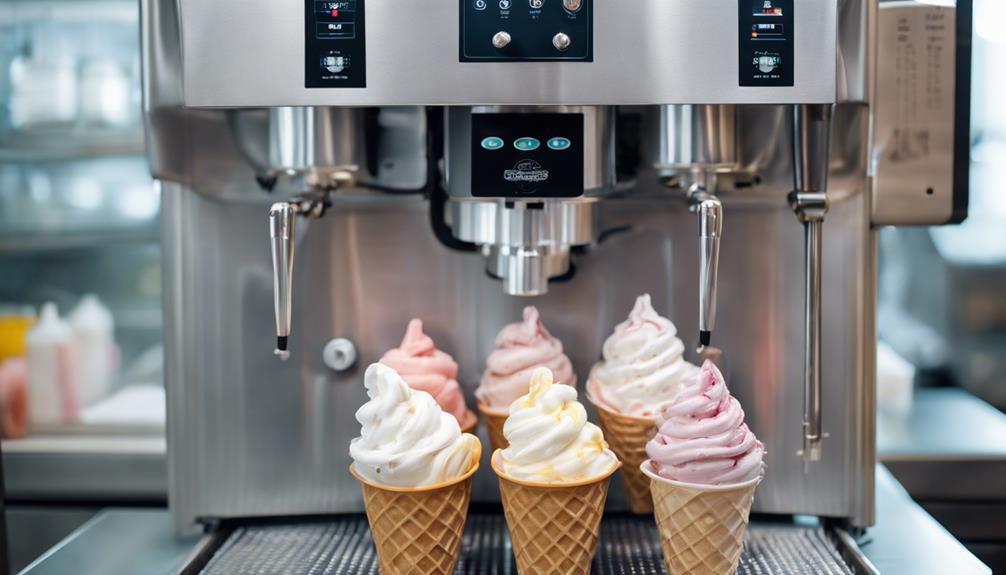
Typically, commercial soft serve ice cream machines consist of several key components essential for producing the desired creamy and delicious frozen treat.
Here are the key components of a commercial soft serve ice cream machine:
- Hopper for Ice Cream Mix: The hopper holds the liquid ice cream mix, ensuring a constant supply for freezing and churning.
- Freezing Cylinder: This component cools and freezes the ice cream mix to the perfect consistency, resulting in a smooth texture.
- Dasher (Agitator): The dasher continuously mixes the ice cream to prevent the formation of large ice crystals, guaranteeing a creamy finish.
- Compressor for Refrigeration: The compressor powers the refrigeration system, maintaining the ideal temperature for freezing and churning the ice cream mix efficiently.
With these components working seamlessly together, commercial soft serve ice cream machines can consistently produce the beloved frozen dessert that brings joy to ice cream lovers everywhere.
Frequently Asked Questions
How Does an Ice Cream Machine Work?
Ice cream machines work by freezing and churning a mixture of cream, sugar, and flavorings. The freezer bowl or compressor freezes the mix, while a paddle stirs it to create a smooth texture. Enjoy your favorite treat!
How Did the Old Ice Cream Makers Work?
You know how old ice cream makers used a hand-crank to churn the mixture surrounded by ice and salt? Churning incorporated air, preventing big ice crystals and resulting in the creamy texture we love.
How Does an Old Fashioned Ice Cream Churn Work?
To make ice cream in an old-fashioned churn, you turn a handle that stirs the mixture, adding air for a creamy texture. The constant churning prevents large ice crystals, while a mix of ice and salt freezes the treat as you go.
How Is Ice Cream Made Step by Step?
Crafting ice cream is akin to a delicious science experiment. You mix cream, milk, sugar, and flavors, then freeze the concoction while churning to create a creamy delight. The secret? Small ice crystals for smoothness.
What Makes Control Tower Ice Cream Different from Regular Ice Cream?
Control Tower Ice Cream stands out from regular ice cream because of its unique flavors and premium quality. These tasty ice cream treats are made with fresh, natural ingredients and offer a richer, creamier texture. Unlike regular ice cream, Control Tower Ice Cream offers an indulgent experience that is truly one of a kind.
Conclusion
Now that you know how an ice cream machine works, you can immerse yourself in the delicious world of homemade treats!
So go ahead, scoop up some fun and whip up your favorite flavors with ease.
Let your creativity swirl and twirl like a soft serve cone on a hot summer day.
Get churning and let the sweet memories melt in your mouth!
